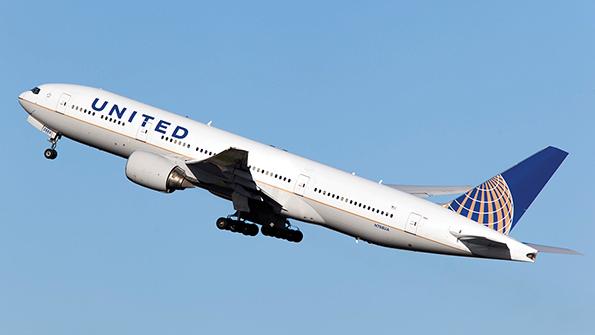
Pratt & Whitney’s lack of sufficient training for an inspection process set the stage for a PW4077 fan blade to fracture, forcing the crew of a United Airlines Boeing 777-200 to shut the engine down and declare an emergency while en route to Honolulu from San Francisco, the National Transportation Safety Board (NTSB) says in its final report.
The February 2018 incident’s roots trace back to 2005, when Pratt developed a thermal acoustic imaging (TAI) inspection process for the interiors of hollow-core PW4000 fan blades. When the process was introduced, Pratt followed “standard nondestructive testing industry practice” and categorized it as “new and emerging,” meaning it could be used while formal training requirements were being developed. But Pratt did not develop a formal, extensive training program until after the United engine failure.
From the outset of the inspection program to the time the United Airlines fractured fan blade was inspected and up to the time of the incident, Pratt “did not have a defined training and certification regimen for the TAI inspectors” at the company’s East Hartford, Connecticut, overhaul facility, the NTSB says.
Instead, the technicians were given about 40 hr. of on-the-job training. By contrast, eddy current and ultrasonic inspection training programs include 40 hr. of classroom learning and at least 1,200 hr. of practical experience, the NTSB says.
The NTSB found that the lack of a formal TAI training program contributed to technicians misdiagnosing an issue multiple times on the United blade that failed, mistakenly believing the finding was a product of the TAI process, not a problem with the blade.
“At the initial TAI accomplished on the fractured fan blade in 2010, there was a small indication at the location of the origin of the crack,” the NTSB says. “Review of the records from the 2015 TAI shows that there was a larger indication in the same area. At the time of each TAI, the inspectors attributed the indication to a defect in the paint that was used during the TAI process and allowed the blade to continue the overhaul process and be returned to service.”
The 40.5-in., No. 11 fan blade fractured across the airfoil about 1.44 in. above its fairing at the leading edge and slightly below the surface of the fairing at the trailing edge, the NTSB says. “Laboratory examination of fan blade No. 11 revealed a low-cycle fatigue fracture that originated on the interior cavity wall directly below the surface.”
The incident occurred as United Flight 1175 was cruising at FL360 en route to Honolulu. “The flight crew heard a loud bang that was followed by a violent shaking of the airplane followed by warnings of a compressor stall,” the report says. The crew shut down the affected No. 2 engine, declared an emergency and proceeded to Honolulu without further issues.
Post-incident examination showed that “most of the inlet duct and all of the left and right fan cowls were missing,” the NTSB says. Fan blade fragments also caused two “small punctures” in the right-side fuselage.
Soon after the incident, Pratt “reported that they had developed a curriculum for TAI initial and recurrent training,” the NTSB says. It also reviewed records for all 9,600 PW4000 112-in.-dia. fan blades that had been previously inspected. A March 2019 FAA airworthiness directive mandated recurring inspections for all in-service blades.



